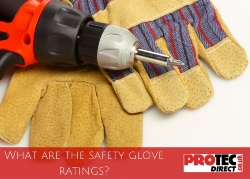Not all gloves are created equal. It’s fair to say we’ve all had experiences of that in our day-to-day lives. Whether it’s wearing thin and flimsy gloves on a cold day and still having frozen hands, or trying to put on a pair of cheap rubber gloves to do the washing up – having the wrong gloves makes a difference.
However, when it comes to cut resistant gloves used for personal protective equipment, or PPE for short, the differences can have more serious consequences. In order to conform to the European regulations surrounding gloves and PPE, they must have been designed according to PPE directive 89/868/EEC.
In short, what this means is that all gloves used for PPE must meet certain standards according to a three category safety glove rating system. This is designed to help employees and employers know which gloves are suitable for certain tasks. Here’s a quick summary of what the levels mean.
Category 1 – Simple Design
These gloves are designed for tasks that involve minimal risk of injury or illness when gloves are not used, or when such consequences are easily treated or reversible. This would essentially be everyday tasks such as washing up, applying non hazardous materials and substances where the risk is very small or only applies to possessions or equipment (such as oiling a bike chain). These gloves are marked with the CE typical safety marking.
Category 2 – Intermediate Design
Gloves in this category are designed for areas where there is a specific risk of injury. These gloves are tested against the European body standard in order to qualify for their safety rating (designated by a CE sign with accompanying 3121 marking). These gloves are required when there is a risk of injury or contamination during use, for example when using machinery or substances that are potentially hazardous. The gloves should be tear resistant, blade cut resistant and puncture resistant.
Category 3 – Complex Design
These are gloves designated for use when there is a serious risk of illness or injury when not used, which is often irreversible and long term. These safety gloves must be tested by an approved quality system. They are marked with the CE sign followed by the numbers 1234 and are resistant to permeation by chemicals.
Gloves are often designed for specific protective purposes. For example, some are cut resistant and others resistant to chemical penetration. Look out for symbols showing for which purpose specific gloves are designed. Within each field there are certain levels of protection that the gloves should offer. This, in combination with the glove categories mentioned above, should give you an idea of which gloves are safe to use for PPE.
Safety standards applied across the board like this help to keep us all safer at work. By understanding the rating system and applying these safety glove regulations to the workplace, we can protect our hands and prevent injury.





Leave a comment